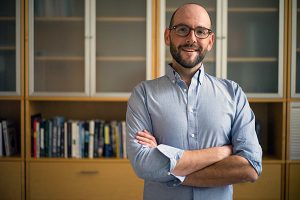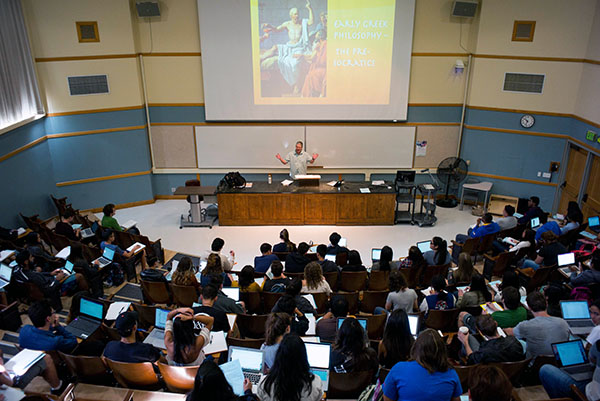
Gordon Douglas, a professor in the Department of Urban and Regional Planning applies his knowledge of communications and sociology to his interdisciplinary research on unauthorized do-it-yourself urban planning. (Photo: James Tensuan, ’15 Journalism)
By David Goll
As with many institutions of higher education, students at San Jose State University are exposed to a variety of subjects through their lower division GE courses. But many professors are also taking interdisciplinary approaches within courses, providing students with a deeper understanding of how knowledge and skills can span across majors.
Costanza Rampini, Tasha Reddy and Bettina Brockmann are taking a multi-pronged approach to tackle the myriad of issues involved with climate change in a course they are teaching this year. The trio of instructors is examining the issue through the academic lenses of science, economic and social impacts, and communications, among others.
For today’s college students, climate change is not some distant, theoretical menace years away that is unlikely to affect their lives. Many want to learn as much about the issue as possible to confront what they consider a real threat to their futures.
They view this cross-disciplinary approach as the ideal way to educate the upcoming generation of citizens and leaders on this vast subject.
The twice-weekly, two-semester course — Global Climate Change — earns six units this fall and three next spring for its 90 enrolled students (though the class capacity is 120.) It is comprised of mostly juniors and seniors majoring in communications, environmental studies or a multitude of other majors such as physics, theatre arts, economics and public relations, among others.
Developed in 2007, Global Climate Change is in its 10th year and has served nearly 1,000 students, according to Anne Marie Todd, a professor of Communications. Integrating climate science with policymaking, public communication strategies and principles of climate justice, students complete the course as climate experts. It’s the only course of its kind at SJSU and in the CSU and has twice been recognized by the American Association of Colleges and Universities (AAC&U) for educational excellence.
“Students love community engagement projects that promote climate change awareness in schools, neighborhoods and businesses,” Todd said. “For example, students create educational materials integrating climate science with practical knowledge in English, Spanish and Vietnamese. Students have founded nonprofit groups and developed programs that support ongoing community educational initiatives.”
Recent surveys and focus group interviews of course alumni show that students feel a lasting personal connection to climate change and a strong sense of personal obligation and perceived individual agency to address climate change in their personal and professional lives.
“I think ours is a unique approach,” said Rampini, who earned a Ph.D. in environmental studies, focusing on climate change adaptations in India, from the University of California, Santa Cruz in 2016. She is in her second year as an SJSU lecturer.
Jamie Pilar, a senior majoring in communications studies, said she was not a climate change skeptic, but also not a passionate advocate in favor of taking action on the issue when she enrolled in the class this fall. But her class experience has changed her outlook, and she has found a cause worth studying and promoting.
“I’m a communications student, and I’ve never particularly liked science,” Pilar, who transferred to SJSU from Ohlone College, said during a break in the class held in Washington Square Hall. “This class has challenged me to view the issue of climate change from many different perspectives. I’ve started talking about this with my friends and family. They’re surprised I’ve developed such a strong interest and point of view on this subject.”
Pilar has learned to appreciate the natural science instruction of Reddy, the newest member of the teaching team who started at SJSU in August after completing post-doctoral work on climate change in the Arctic Ocean region using supercomputers. She discusses the Earth’s climate systems and how humans have an impact on climate through their activities. Rampini enlightens students on how humans are in turn affected by climate change.
Another student Akash Patel recently interact with former Vice President Al Gore during a livestream Q&A about An Inconvenient Sequel. Patel asked what students can do to influence a tax on carbon system. View a video of the encounter online.
Brockmann, who came to the United States from Germany 19 years ago and has been teaching this class since 2012, highlights how climate scientists and climate change advocates can effectively communicate their message to the public.
“The multi-disciplinary approach helps students make connections,” Rampini said.
That multi-faceted teaching style informs not only the classroom presentations of Gordon Douglas assistant professor of SJSU’s Urban and Regional Planning department but also guides him in conducting his academic research.
That includes the extensive, wide-ranging research he compiled for his book about unauthorized do-it-yourself urban planning done by residents of large cities in North America and Europe, titled “The Help Yourself City.” Described as a multi-disciplinary urbanist, Douglas is a newcomer to SJSU, having joined the Department of Urban and Regional Planning this fall. He earned his Ph.D. in Sociology from the University of Chicago, a master’s degree in Global Communication from the USC Annenberg School for Communication and a bachelor’s degree in International Relations from the University of Southern California, among other academic achievements. He completed his post-doctoral work at New York University’s Institute for Public Knowledge.
Douglas conducted more than 100 interviews for his forthcoming book, spending many weeks doing research in such cities as Los Angeles, Vancouver, Toronto, New York and London. Delving into his interest in culture and gentrification, he studied how residents of these cities created their own pocket parks, median-strip gardens, pedestrian seating, unofficial bike lanes and even their own system of directional signs along streets in an ultra-conservative Jewish enclave in the New York City borough of Brooklyn — independent of city planners.
Compiling both quantitative and qualitative data and statistics, Douglas also returned to his hometown, Davis, to study how Minneapolis-based Target Corp. managed to build the first big-box retail outlet in the famously slow-growth university town of 65,000 west of Sacramento. A development particularly surprising after city’s voters rejected a proposal for a second Village Homes project to create another green, sustainable residential community.
“An interesting study into how large companies can get what they want, even in unexpected places,” Douglas said.
He now teaches Social Issues in Planning and a course in Urban Design at SJSU. Douglas also serves as director of the university’s Institute for Metropolitan Studies and will be working with his students to create a documentary film series.


